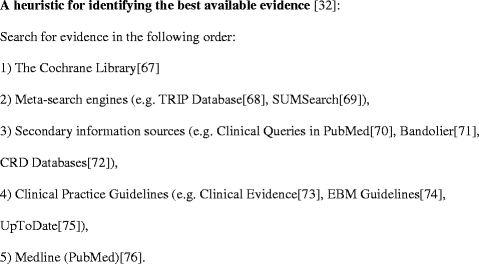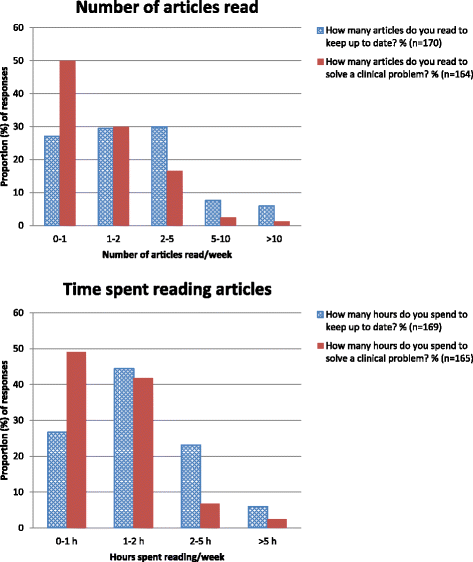The design, fate and impact of a hospital-wide training program in evidence-based medicine for physicians - an observational study
- PMID: 26956890
- PMCID: PMC4784409
- DOI: 10.1186/s12909-016-0601-9
The design, fate and impact of a hospital-wide training program in evidence-based medicine for physicians - an observational study
Abstract
Background: Many doctors fail to practice Evidence-Based Medicine (EBM) effectively, in part due to insufficient training. We report on the design, fate and impact of a short learner-centered EBM train-the-trainer program aimed at all 2400 doctors at the Karolinska University Hospital in Sweden on the heels of a tumultuous merger, focusing particularly on whether it affected the doctors' knowledge, attitudes and skills regarding EBM.
Methods: We used a validated EBM instrument in a before-and-after design to assess the impact of the training. Changes in responses were analyzed at the individual level using the Wilcoxon matched pairs test. We also reviewed documentation from the program - including the modular EBM training schedule and the template for participants' Critically Appraised Topic reports - to describe the training's content, design, conduct, and fate.
Results: The training, designed to be delivered in modules of 45 min totaling 1.5 days, failed to reach most doctors at the hospital, due to cost cutting pressures and competing demands. Among study participants (n = 174), many reported suboptimal EBM knowledge and skills before the training. Respondents' strategies for solving clinical problems changed after the training: the proportion of respondents reporting to use (or intend to use) secondary sources "Often/very often" changed from 5 % before the training to 76 % after the training; in parallel, reliance on textbooks and on colleagues fell (48 to 23 % and 79 to 65 %, respectively). Participants' confidence in assessing scientific articles increased and their attitudes toward EBM became more positive. The proportion of correct answers in the EBM knowledge test increased from 52 to 71 %. All these changes were statistically significant at p < 0.05.
Conclusions: Many study participants, despite working at a university hospital, lacked basic EBM knowledge and skills and used the scientific literature suboptimally. The kind of short learner-centered EBM training evaluated here brought significant improvements among the minority of hospital doctors who were able to participate and, if applied widely, could contribute to better, safer and more cost-effective care.
Figures


Similar articles
-
Awareness, attitudes, barriers, and knowledge about evidence-based medicine among family physicians in Croatia: a cross-sectional study.BMC Fam Pract. 2020 May 16;21(1):88. doi: 10.1186/s12875-020-01162-5. BMC Fam Pract. 2020. PMID: 32416714 Free PMC article.
-
Evaluating the impact of an evidence-based medicine educational intervention on primary care doctors' attitudes, knowledge and clinical behaviour: a controlled trial and before and after study.J Eval Clin Pract. 2007 Aug;13(4):581-98. doi: 10.1111/j.1365-2753.2007.00859.x. J Eval Clin Pract. 2007. PMID: 17683300 Clinical Trial.
-
Knowledge and attitudes of trainee physicians regarding evidence-based medicine: a questionnaire survey in Tehran, Iran.J Eval Clin Pract. 2008 Oct;14(5):775-9. doi: 10.1111/j.1365-2753.2008.01073.x. J Eval Clin Pract. 2008. PMID: 19018910
-
Links between evidence-based medicine and shared decision-making in courses for doctors in training: a scoping review.BMJ Open. 2022 Apr 25;12(4):e057335. doi: 10.1136/bmjopen-2021-057335. BMJ Open. 2022. PMID: 35470193 Free PMC article.
-
Does evidence-based medicine training improve doctors' knowledge, practice and patient outcomes? A systematic review of the evidence.Med Teach. 2019 May;41(5):532-538. doi: 10.1080/0142159X.2018.1503646. Epub 2018 Oct 17. Med Teach. 2019. PMID: 30328793
Cited by
-
Self-perceived knowledge, attitude, and practice of evidence-based medicine before and after training among healthcare workers in Taizhou, China.BMC Med Educ. 2024 Jun 27;24(1):700. doi: 10.1186/s12909-024-05678-7. BMC Med Educ. 2024. PMID: 38937713 Free PMC article.
-
Why do medical residents prefer paternalistic decision making? An interview study.BMC Med Educ. 2022 Mar 8;22(1):155. doi: 10.1186/s12909-022-03203-2. BMC Med Educ. 2022. PMID: 35260146 Free PMC article.
-
Awareness, attitudes, barriers, and knowledge about evidence-based medicine among family physicians in Croatia: a cross-sectional study.BMC Fam Pract. 2020 May 16;21(1):88. doi: 10.1186/s12875-020-01162-5. BMC Fam Pract. 2020. PMID: 32416714 Free PMC article.
-
Examining aptitude and barriers to evidence-based medicine among trainees at an ACGME-I accredited program.BMC Med Educ. 2020 Nov 10;20(1):414. doi: 10.1186/s12909-020-02341-9. BMC Med Educ. 2020. PMID: 33167917 Free PMC article.
-
Does a one-day workshop improve clinical faculty's comfort and behaviour in practising and teaching evidence-based medicine? A Canadian mixed methods study.BMJ Open. 2017 Jul 13;7(7):e015174. doi: 10.1136/bmjopen-2016-015174. BMJ Open. 2017. PMID: 28710209 Free PMC article.
References
-
- Institute of Medicine (U.S.); Committee on Quality of Health Care in America . Crossing the quality chasm : a new health system for the 21st century. Washington: National Academy Press; 2001.
-
- McGlynn EA, Asch SM, Adams J, Keesey J, Hicks J, DeCristofaro A, Kerr EA. The quality of health care delivered to adults in the United States. N Engl J Med. 2003;348(26):2635–45. - PubMed
Publication types
MeSH terms
LinkOut - more resources
Full Text Sources
Other Literature Sources

